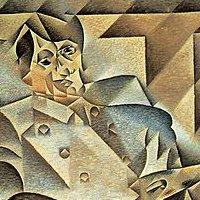
We mentioned before that, when deconstructing everyday objects, faces and landscapes into geometric shapes, Picasso worked without colour, but he used to stick on press cuttings, paper and other items not previously used in art. In this early period, the absence of colour and the use of ochre or grey tones, or even just black and white, were the defining visual features of many Cubist artworks.
Over time, Picasso’s Cubism evolved to incorporate colour as a subjective way to interpret reality, so the artists alter natural colours and subjecting them to their own creative will.
As we saw with the work of Medardo Rosso, sculpture also underwent a process of renewal. Sculpture, too, was adapted to the new artistic language by Picasso. One of his great contributions to sculpture, both simple and revolutionary at the same time, was the invention of the vacuum; the empty space used as an integral part of the artwork.
Close to you now, you can find his work “Head of a Woman”, which uses this very idea. Sculpted work made it necessary to find another way to represent movement, just as in painting, this was done by showing three dimensions simultaneously on a flat surface.
(c) (R) 2012, MUSMon com S.L.
The Reina Sofia MUSMon.com audioguide makes a better visit to the "Museo Nacional Centro de Arte Reina Sofia" (MNCARS). It is an independent production from the museum. It offers 67 minutes of two voices narrations with 43 explanations of works, authors and artistic trends.
It comes with 65 photographs, and museum plans. It also includes the full text transcriptions of voiceover, technical data and several organized itineraries. +info





















































